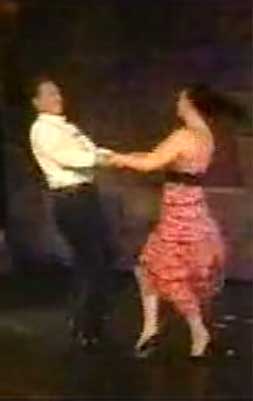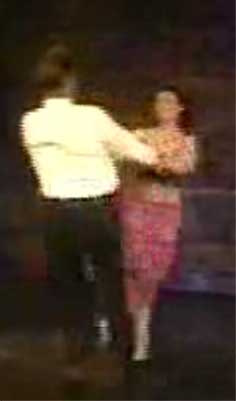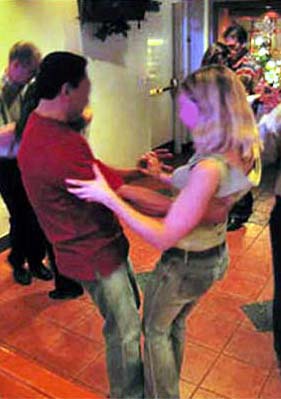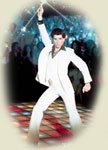Is Tango Just for Old Folks?
A couple of years ago Alejandra and I were at a dinner party in Tucson when a slightly drunk woman began to lecture the table. She had just returned from a tango nuevo workshop, and she insisted loudly that people who don’t like tango nuevo are dull, conservative, and generally lacking in imagination. In short, she felt that people in tango who don’t want to kick up their heels are, uh, you know... old and not cool. I was around in the 1970’s, so this "generation gap" argument is one I’ve heard before. (Although it was the first time I'd heard it repeated so many times and so forcefully by a middle aged woman).
I guess the question is whether there really is a division in tango between the young and speedy, and the old and sedate. I think there is—although it may not be where you'd expect. I don’t see a real division in age between the people who like to dance traditional social tango in the milongas and the more acrobatic stage tango taught in most workshops (which includes the "nuevo" or "alternativo" versions). At least not here in BsAs. What we have seen, including in places like Villa Malcom and La Viruta, which are often cited as centers of new tango styles, is that while many young people begin with performance style tango, they often move into the social style of the milongas. Understandably, new dancers who haven't become addicted to the subtleties of Golden Age music, might gravitate toward stage tango. I can see how they might find the active moves designed for exhibition to be more interesting—but that's not just limited to young people. My experience, both inside and outside of Argentina, is that there are just as many old dancers as young ones who disrupt the milongas with performance tango. The real tango generation gap is not between social dancers and stage dancers—it's between the people who like the old stage tango, and those who prefer the new stage tango.
In the1990s, Tango Argentino and Forever Tango introduced tango to the world. Lots of people saw the shows and decided they wanted to dance tango, so the stage tango that was popularized by people like Todaro, Copes, and the Dinzels, began to be taught all over the place. Today, however, the first generation of traveling Argentines who popularized it is shrinking, and a new wave of Argentines with a new set of choreography is taking over. Names like Eduardo and Gloria, and Nito and Elba, are being replaced with names like Fabian, Chicho, and El Pulpo. Almost every tango community has some older couples still teaching the front ochos, ganchos, and sentadas they learned in the 1990s—but now they have to compete with younger teachers selling volcadas, colgadas, and piernazos.
And that’s where the generation gap lies—within that large, worldwide community of amateur and professional tango instructors who look for students by performing show tango, and then teaching what they perform. And their continued existence depends on the blurring of the lines between social tango and performance tango.
Buyer Beware: The Style Myth
Argentines know there are really only two styles of tango. There's the showier version used by performers that they call "tango escenario" or "tango fantasia" (stage tango), and there's the social tango for dancing in the milongas that they call "tango salon" (“dance hall tango”). It’s simple, and it makes sense. But then it began to get mixed up.
Up until about 15 years ago, almost all of the tango being taught was stage tango. It was taught by professional performers who used the time between shows to give classes. Then in 1990s there was a tango boom, and people in Argentina began to rediscover the milongas—but the opportunity to learn tango in the traditional way was almost gone. Social tango had gone to sleep, and for the previous 35 years tango had existed mostly in the form of exaggerated street performances and stage shows for tourists. The old ways of slowly learning how to dance were almost gone. There just weren’t enough people left who could carry on the traditions of practicing at home with family members, playing with tango on the street corners, and serving apprenticeships in neighborhood clubs. So a few people began to try something new. They decided to teach the social tango of the milongas by giving classes.
The new classes were based on responding to the cadences of the music, connecting closely with a partner, and moving smoothly around a crowded floor. Admittedly they only scratched the surface—but they did cover basic technique, and because they were so different from the dramatic figures and complex choreography being taught by the performers, the new teachers needed a way to make a clear distinction between their social tango, and the classes that already existed. The problem was that many of the performers already used the label "tango salon" to advertise their classes—so some of the new instructors decided to call their classes "tango milonguero". They simply replaced the word "salon" with "milonguero". "Tango salon" means tango for dancing socially in a dance salon (which is a milonga), and "tango milonguero" means the kind of tango danced in a milonga. Technically they are exactly the same thing. But since the stage teachers had already grabbed the “tango salon” label, the new teachers had to come up with a new name.
This is probably where the confusion began—but the important thing to remember is that “tango milonguero” is not some separate "style" of tango danced by the old milongueros.
Tango milonguero = tango for a milonga = tango salon.
Tango milonguero ≠ a special type of tango danced by old milongueros.
Old milongueros don't dance differently than any of the other social dancers in BsAs. They are simply the ones who've been dancing the longest. This means they may dance better than most... but they dance the same rhythmic, flowing, tango as everyone else who knows the right way to dance in a milonga.
The problem is that many people mistakenly assumed that tango milonguero referred only to the old milongueros. And if it did—if tango milonguero actually was a specific, separate style of social tango that old milongueros danced, then it was logical to assume that other people must be dancing other styles of tango in the milongas... and they began to find them.
The Confusion Grows
There is a new thing in academic circles called “postmodernism”. It goes something like this: There is actually no fixed reality. Words mean whatever you think they mean. And if enough people believe the words, then they eventually create a shift in perception—and this shift in perception eventually spawns a new reality. I’m not sure I understand it… but look at what happened in tango: Without actually spending time dancing in the milongas and becoming part of the culture, or even talking to anyone who was, some people began to argue that there was a special style of tango danced by the old milongueros called tango milonguero. So when they saw an old man using short steps on a crowded floor, “tango milonguero” became a tango style danced with short steps. But sometimes dancers also used long steps, and since there was already something called “tango salon”, then tango salon must be the tango with long steps. Then, they noticed that some people were dancing to quick rhythms (this must also be the milonguero style) and other times people were dancing more slowly (this must be the salon style). But it didn’t stop there. They even assumed people who were simply using poor technique, like dancing on bent legs, were displaying another one of the styles... and the imaginary styles began to grow.
Sometimes people leaned into each other when they danced (milonguero?). Others leaned a lot, while some leaned less (Close-embrace style? Urquiza style?). Others didn’t lean at all. It was noticed that some landed more on the front of their foot, and others landed more on the heel, and people even noted slight differences in the relative chest positions of the partners—were they chest to chest, or was the woman an inch to the side? Sub-categories began to appear. Was that couple dancing Milonguero... or a subcategory called Apilado? Maybe it depended on where people danced, or how they stepped. Sometimes people picked up their feet more, or separated a little, and came back together. Was this a subcategory or a different style? Maybe it was the Club Style, or the Orillero Style. And what's worse, people who didn't understand the difference between stage tango and the tango of the milongas began to argue that the poses and figures taught in classes were different styles of social tango.
When I first began to learn tango I bought dozens of I instructional videos, and most of them claimed to teach a different style. Today there are traveling teachers adding things from other types of dancing and labeling it Tango Nuevo, or teaching a lot of embellishments, and calling it Tango Salon. But with all the video we've shot and all the dancing we've done, I've never been able to find any of these styles in the milongas. Today, whenever I hear someone claiming there are separate, distinct styles of social tango with different names, I know right away they are from the academic-performing world. The world of workshop tango.
So a misunderstanding over the meaning of a couple of words may have created a new reality that allowed a confusing mix of tango styles came into being. Which of course is a wonderful thing… for the people who are in the business of selling tango lessons. Teachers and performers need to promote themselves, and if they can find a hook, they’ll use it. There's nothing wrong with selling something, but keep in mind that a lot of what you see and read in tango is marketing. Teachers and performers are constantly inventing new "styles" by adding things to tango. It's part of their job. The more new categories they can invent, the more things there are to teach. If instructors can differentiate themselves and get more students by teaching tango with lots of small steps and selling it as Milonguero, or by teaching long steps and calling it Villa Urquiza, they’ll do it.
But the truth is that good social dancers dance in all sorts of ways. They change their dancing depending on the music, and they may dance differently with different partners. They may even do different things simply because they feel different from time to time, and they may make changes during one tanda… or even in one tango. There is an amazing variety of musical expression among good social dancers, but they all dance within the well defined boundaries of social tango. And it’s the obligation of everyone who attends a milonga to learn and respect those boundaries.
So in the end who should you listen to? Well, maybe the best tango advice came El Gallego's father almost 60 years ago. When El Gallego began to dance, his dad told him, "Stand up straight, learn how to step, and listen to the music."
Neotango and All That

Lawrence Welk
There used to be a program on TV in the U.S. called the “Lawrence Welk Show”—and if you really want to understand the meaning of “generation gap”, that’s where you should look. The show was ground zero in the war between children and their parents in the 1960s. It was a line drawn in the sand between everybody over 30 (who loved the show), and everybody under 30 (who hated it). It was aired on Sunday nights, and my elderly aunts and uncles actually scheduled their day around it. But I couldn’t even stand to be in the room when it was on. For me it was absolutely the most unhip, uncool, kitschy piece of trash that was ever created. But I’ve mellowed a little since then. Today, I think of it as being something like tango nuevo.
“Lawrence Welk” was a variety show where they played popular music, and people would sing and do dance routines. One secret to its success was that no matter where the music came from, it was always cleaned up and arranged in a way that was comfortable and familiar. Whether the music was from Africa, Asia, Latin America, or New Orleans, it all came out sounding very… “Middle-American”. Same with the dancing. The wholesome young couple that performed on the show might dress up like gypsies or gauchos or Cossacks, but they kept smiling and dancing like the polite boy and girl next door. And even though they sometimes danced around in calypso outfits or hula skirts, they were careful to avoid sexy hip movements.
The man who danced on the show was named Bobby, and he started out as a Mouseketeer on "The Mickey Mouse Club". There's a funny video of him teaching the Chicken Dance on YouTube—and it includes a move that was very popular in tango nuevo a few years back! It's the one where the couple puts their feet very close together, leans back, and spins around. These back-leaning, spinning giros seemed to be showing up everywhere in tango a few years ago, but I haven't seen them lately:


Spinning class: Bobby demonstrating the Chicken Dance

Spinning in a milonga in the U.S. (ca. 2004)
Lawrence Welk's music was popular, but it wasn't very good. And I feel the same way about neotango. Take a tangoish theme and rearrange it in a way that the current global youth culture finds comfortable and familiar, and you've got tango nuevo. Add a techno-trance sound, and you have perfect background music for a free form volcada-piernazo workout. (I may be risking the scorn of that woman from the dinner party by writing this, but it doesn’t really matter. I think she found a boyfriend and got bored with tango, so she'll never read it anyway.)
I look at it this way: Most of the original old tango music still sounds pretty good—but I wonder how the new tango music will sound in a few years. Hard to say, but if it's anything like those tangos Lawrence Welk used to play on his accordion, or those spinning giros the cool people were doing a couple of years ago, it will probably fade fast. Of course, as bad as some of this stuff is, it could be a lot worse. The latest tango boom started about 15 years ago, so we're currently seeing tango reinvented as techno-club. But imagine if tango had happened to catch the world's attention 15 years earlier than that. Suppose people outside of Argentina had begun to reinvent tango around 1980... imagine what that would have happened. We would have experienced... Disco Tango!
It was a near miss, and I shudder to think of the possibilities. But maybe we can get an idea. Years ago, Adios Muchachos was rewritten for gringo ears, and given the name I Get Ideas. It was recorded by a lot of different people, and it happens that there was a version recorded right smack in the middle of the disco era. For those brave souls who want to find out how much cultural modification tango can stand, check out Adios Muchachos morphed into I Get Ideas, and sung by Tony Orlando and Dawn. I'm not kidding. You can listen to it on the Internet.
 Keep on readin'...
Keep on readin'...